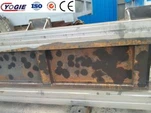
Helical gears and double helical gears are both types of gears used in mechanical systems, but they differ in their tooth arrangements and design. Here are the key differences between helical gears and double helical gears:
Tooth arrangement
Helical Gears: In helical gears, the teeth are inclined at an angle to the gear axis. This angle is called the helix angle. The helix angle can vary, and it is responsible for the smooth meshing of the gears, resulting in reduced noise and vibration.
Double Helical Gears: Also known as herringbone gears, double helical gears have two sets of teeth that are mirror images of each other, forming a V-shape. This design eliminates axial thrust, which is a force along the gear axis that tends to push the gears apart. The double helix arrangement cancels out the axial forces, providing better load distribution.
axial thrust
Helical Gears: Due to the helix angle, helical gears generate axial thrust during operation. This axial thrust needs to be addressed using thrust bearings or other mechanisms.
Double Helical Gears: The double helix design inherently cancels out the axial thrust, resulting in a gear system that doesn't require additional thrust bearings.
manufacturing complexity
Helical Gears: Helical gears are relatively simpler to manufacture compared to double helical gears.
Double Helical Gears: The manufacturing of double helical gears is more complex due to the need to create the V-shaped teeth and ensure proper alignment.
noise and vibration
Helical Gears: Helical gears generally produce less noise and vibration compared to spur gears because of the gradual engagement of teeth.
Double Helical Gears: Double helical gears, with their dual-helix design, further reduce noise and vibration, making them suitable for applications where minimizing these factors is crucial.
applications
Helical Gears: Commonly used in various applications, including automotive transmissions, industrial machinery, and power transmission systems.
Double Helical Gears: Found in applications where the elimination of axial thrust is essential, such as heavy-duty gearboxes and high-torque applications.
summary
In summary, while helical gears have a single helix angle and generate axial thrust, double helical gears feature a dual-helix design that cancels out axial thrust and offers additional benefits in terms of load distribution and reduced noise. The choice between the two depends on the specific requirements of the application.







